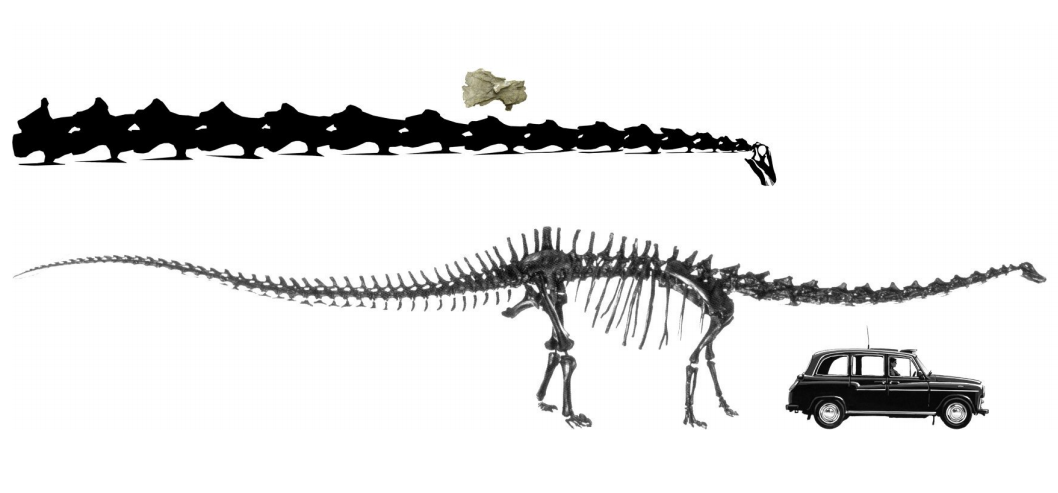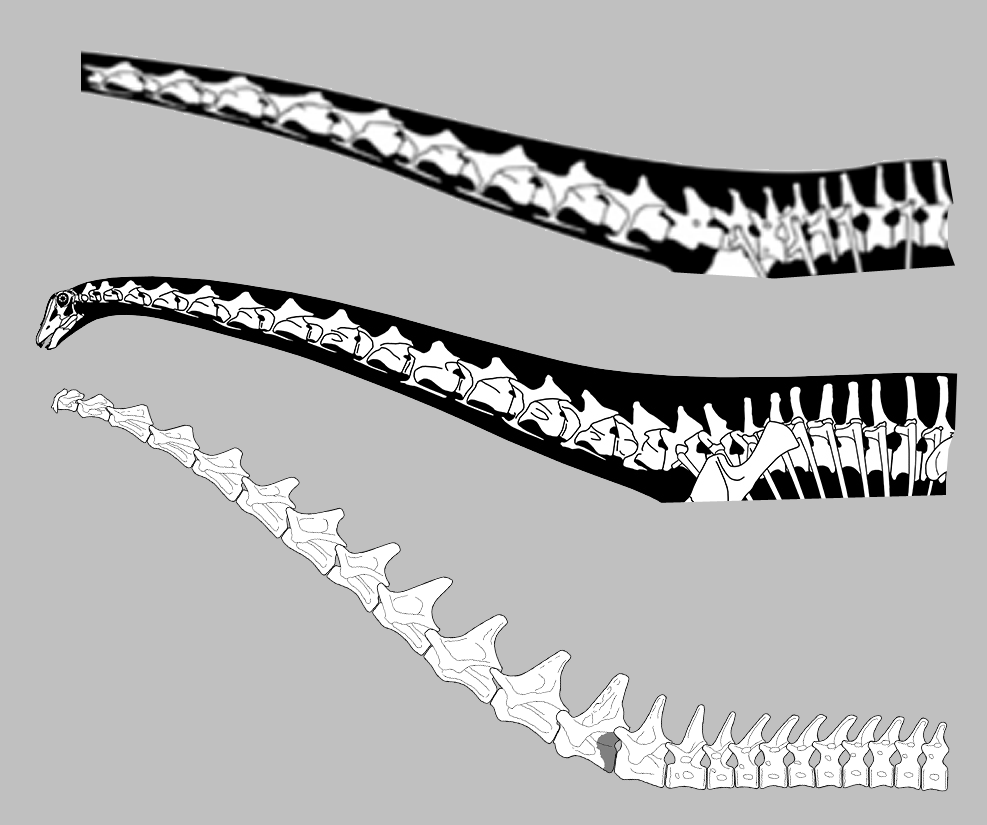Ever since the giant sauropod cervical BYU 9024, formerly interpreted as part of the Supersaurus vivianae holotypic individual, was reinterpreted as a Barosaurus cervical based on a careful analysis by Matt Wedel and Mike Taylor which was presented in the 2016 SVPCA, it has been the subject of several discussions regarding the speculated total body size of the animal it would have belonged to. The cervical, most likely the 9th, is twice as long as the 9th cervical in the mounted Barosaurus lentus skeleton AMNH 6341, and based on direct isometric scaling, could have belonged to a truly gargantuan animal in life, with a neck extending an estimated 17 metres when scaled from the mounted skeleton (only matched by the giant mounted specimen of Mamenchisaurus sinocanadorum from Tokyo so far) and a total axial length easily over 50 metres.

However, it has been proposed several times in discussions about the potential size of the animal that the neck length would have scaled with positive allometry, with BYU 9024 having a proportionally longer neck than in AMNH 6341, the rest of the body scaling by a lesser factor than what isometrically scaling via cervical centrum length would suggest. This is based on a study by Parrish & Michael (2006) which found that sauropod necks in general scale with positive allometry, to the power of 1.35. This is due to selective pressures for larger feeding envelopes as sauropods got larger and larger.
The increase in neck length can come in any of these ways: increasing cervical centrum lengths, addition of more cervicals, or both. Given the diagnosis of BYU 9024 as Barosaurus, and that animals within the same genus tend to be similar skeletally with no differences in precaudal count, it’s safe to say that BYU 9024 would have had the same number of cervicals as B. lentus (16 cervicals). Thus, if BYU 9024 scaled with positive neck allometry, it would have done so by making the cervicals proportionally longer in comparison to the rest of the body. This seems reasonable on paper given what we know about sauropod ecology and allometric trends so far. Without the rest of the body of the animal BYU 9024 belonged to, we wouldn’t exactly have a way to test against this…right? Right?
Turns out there is – the aspect ratio of the centra. One can look at the relationship between centrum length and centrum diameter and see how elongate it is, and this is the central factor in determining whether the centrum length scaled positively allometrically or not. The allometric scaling by Parrish & Michael (2006) does not concern neck depth or width, and for good reason – the selective pressures for longer necks and large feeding envelopes in sauropods wouldn’t affect centrum diameters as increasing them wouldn’t provide any advantage in this regard, and thus they would be left to scale as the rest of the body would. Thus, the length of the centrum would increase with positive allometry with respect to centrum diameter and thus the centrum would be expected to get more elongated in larger sauropods. This is exactly what we see when we compare the cervicals of giant supersauropods to the centra of medium to small sauropods.

Given this information, we should expect BYU 9024 to be more elongate than the corresponding element in AMNH 6341. Using the allometric scaling presented by Parrish & Michael, as the neck scales by the power of 1.35 in relation to the rest of the body, and provided that the centrum diameter scales with the same factor as the rest of the body does, then while the length of BYU 9024’s centrum is twice that of AMNH 6341, its expected centrum diameter would only increase by a factor of 21/1.35 = 2~0.741 = ~1.671. The expected proportions of BYU 9024 based on this is illustrated below:

How does this prediction match up to reality? Do the expected elongate proportions for BYU 9024 here match up with the actual specimen? If it does, then it would confirm the hypothesis that BYU 9024 had an allometrically longer neck and thus total body size estimates would be revised downwards from the isometrically scaled versions. However, when we do compare this prediction to figures of the actual specimen, it doesn’t stand up at all:

It is immediately clear that the actual specimen doesn’t match the predicted elongation. In fact, BYU 9024 is not even any more elongate than the corresponding AMNH 6341 cervical as-is:

(5/26/2021 update: BYU 9024 is laterally crushed – as brought up by Mike Taylor in the comments below – which would expand the centrum dorsoventrally. However, the condyle as preserved is easily more than twice – around ~2.1-2.4 times by my measure depending on the illustration used for BYU 9024 – as deep as that of an isometrically-scaled AMNH 6341. I’m not even sure that correcting for crushing would be sufficient to bridge this gap, let alone the gap between it and the more elongate model.)
With this in mind, I think the case for BYU 9024’s possible gigapod status is looking pretty good if the cervical’s assignment to the 9th serial position holds. The idea that BYU 9024 had an allometrically longer neck than AMNH 6341 doesn’t exactly show in the proportions of the cervical centrum itself.
But what if it was wrong? What if BYU 9024 wasn’t a 9th cervical, but somewhere more anterior or posterior? We’ll have to test them too, just to cover the possibility. According to Mike Taylor, the proposed likely serial position for BYU 9024 could possibly be off by one or two places, meaning a range from the 7th to the 11th serial positions. And then it doesn’t look like BYU 9024 is any more elongated than those cervicals either:

Thus, even if the serial position assigned to BYU 9024 was slightly off, it still doesn’t look like the cervical centrum grew allometrically longer. The case for a gargantuan Barosaurus still looks pretty good – isometrically scaling, even the posteriormost assignment, yielding a lower bound, still yields a ~15-metre neck which would correspond to a total axial length over 45 metres and an estimated body mass larger than that of most titanosaurs.
Why would the supergiant Barosaurus apparently not evolve a proportionally longer neck despite the selective pressures for longer necks at larger sizes? If I had to guess, it’s probably because the neck of Barosaurus at smaller sizes as-is is already long enough proportionally. The neck of Barosaurus lentus is proportionally longer compared to its body than in similarly-sized diplodocids and even many far larger sauropods. Further increasing the proportional neck length might not be necessary for a scaled-up form to be ecologically viable.

To sum it up, BYU 9024, from what can be gathered from the scientific literature so far, appears to show no allometric elongation from its smaller cousin, using any of the proposed plausible positions for the cervical.
References
- Taylor & Wedel, 2016, “How big did Barosaurus get?”
- Jensen, 1985, “Three new sauropod dinosaurs from the Upper Jurassic of Colorado”
- Jensen, 1987, “New brachiosaur material from the Late Jurassic of Utah and Colorado”
- McIntosh, 2005, “The Genus Barosaurus Marsh (Sauropoda, Diplodocidae)”
- Lovelace et al., 2005, “Revised osteology of Supersaurus vivianae”
- Parrish & Michael, 2006, “The origins of high browsing and the effects of phylogeny and scaling on neck length in Sauropodomorpha”
- Taylor & Wedel, 2007, “Why sauropods have long necks, and why giraffes have short necks”
- Tschopp & Mateus, 2012, “The skull and neck of a new flagellicaudatan sauropod from the Morrison Formation and its implication for the evolution and ontogeny of diplodocid dinosaurs”
So, can you draw a picture about BYU9024 without a 19 meter neck? Many readers love your pictures, especially for Maraapunisaurus. Then we are looking forward seeing you drawing about a supergiant Barosaurus.
LikeLike
Really interesting ideas here, but I think they founder on the very bad crushing at the back of the BYU 9024 cervical. Matt and I don’t even know what the centrum diameters (horizontal or vertical) are, and we have spent a lot of time looking at this thing. For sure, the whole of what looks like the posterior articular surface when you see the vertebra in lateral view is not cotyle. The ventral part of it is folded-down PCDLs that would have projected more ventrolaterally in life.
LikeLike
I’ve have had my suspicions on the back end, it always looked quite like it had seen better days. It’s the front end that’s more significant here I think. The condyle is far deeper than even the isometrically scaled AMNH 6341 cervical. The inclusion of Jensen’s restored cervical was in case that BYU 9024 as-is was deformed by crushing, although it relies on how well Jensen accounted for said crushing.
LikeLike
Hmm, but the condyle is also laterally crushed (and therefore dorsoventrally expanded). I wouldn’t put a huge amount of trust in Jensen’s model.
LikeLike